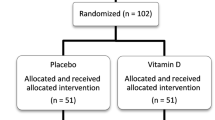Abstract
This study reports the effects of two nutritional products upon the severity of symptoms in children with confirmed diagnoses of Attention-Deficit Hyperactivity Disorder (ADHD): a glyconutritional product containing saccharides known to be important in healthy functioning and a phytonutritional product containing flash-dried fruits and vegetables. Seventeen ADHD children were recruited from a local parent support group. Parents of five of the subjects did not have their children on methylphenidate. Of the remaining twelve, all on methylphenidate, six were left on prescribed doses (random assignment). The other six had their doses reduced by half after two weeks (study duration was six weeks). The subjects were assessed initially and three subsequent times over a period of six weeks (longitudinal nonrandomized design). The behavior disorder items for ADHD, Oppositional Defiant Disorder (ODD), and Conduct Disorder (CD) as listed in the Diagnostic and Statistical Manual for Mental Disorders (DSM IV) (American Psychiatric Association, 1994) were rated by teachers and parents on a 3-point scale. Also included was a Side Effects Scale described by Barkley (1990). The children received the glyconutritional supplement for the entire six weeks. After three weeks, the phytonutritional supplement was added to the diet to increase the probability of positive results. The glyconutritional supplement decreased the number and severity of ADHD, associated ODD and CD symptoms, and side effects in all groups during the first two weeks of the study. There was little further reduction with the addition of the phytonutritional supplement. The three study groups did not differ statistically in degree of reduction over observations. Present results suggest that symptoms of ADHD may be reduced by the addition to the diet of saccharides used by the body in glycoconjugate synthesis.
Similar content being viewed by others
References
American Psychiatric Association. (1994).Diagnostic and statistical manual of mental disorders (4th ed.). Washington, D.C.: American Psychiatric Association.
Barkley, R.A. (1990).Attention deficit hyperactivity disorder: A handbook for diagnosis and treatment. New York: Guilford Press.
Bradley, C. (1937). The behavior or children receiving benzedrine.American Journal of Psychiatry 94:577
Conners, C.K. (1980).Food additives and hyperactive children. New York: Plenum Press.
Dykman, R.A., Ackerman, P.T. & Raney, T.J. (1993).Assessment and characteristics of children with attention deficit disorder. Report prepared for the Office of Special Education (pp. 1–24). Washington, D.C.: Office of Special Education and Rehabilitative Services, U.S. Department of Education.
Feingold, B. (1975).Why is your child hyperactive? New York: Random House.
Goyette, C.H., Conners, C.K., & Ulrich, R.F. (1978). Normative data on the revised Conners parent and teacher rating scales.Journal of Abnormal Child Psychology 6: 221–236.
Greenhouse, S.W. & Geisser, S. (1959). On methods in the analysis of profile data.Psychometrica, 24: 95–112.
Gross, M.D. (1984). Effects of sucrose on hyperactive children.Pediatrtics 74: 876–878.
Hartsough, C.S. & Lambert, N.M. (1985). Medical factors in hyperactive and normal children. Prenatal, developmental, and health history findings.American Journal of Orthopsychiatry 55: 190–201.
Hodgson, J. (1990). Capitalizing on carbohydrates.Biotechnology, 8: 109–111.
Kavale, K.A., & Forness, S.R. (1983). Hyperactivity and diet treatment: A meta-analysis of the Feingold hypothesis.Journal of Learning Disabilities 16(6): 324–330.
Loney, J., & Milich, R. (1982). Hyperactivity, inattention, and aggression in clinical practice. In D. Routh & M. Wolraich (eds.),Advances in developmental and behavioral pediatrics (Vol. 3, pp. 113–147). Greenwich, Connecticut: JAI Press.
Mattes, J.A. (1983). The Feingold diet: A current reappraisal.Journal of Learning Disabilities 16(6): 319–323.
Mayes, P.A. (1996). Carbohydrates of physiological significance. In Murray R., Granner D., Mayes P., Rodwell, V. (eds.).Harper’s Biochemistry (pp. 1356–145). Stamford, Connecticut: Appleton & Lange.
Milich, R., Pelham, W.E. (1986). Effects of sugar ingestion on the classroom and playgroup behavior of attention deficit disordered boys.Journal of Consulting and Clinical Psychology 54(5): 714–718.
Milich, R., Worraich, M.L., & Lindgren, S. (1986). Sugar and hyperactivity: A critical review of empirical findings.Clinical Psychological Review 6(6): 493–513.
Mitchell, E.A., Aman, M.G., Turbott, S.H., & Manuku, M. (1987). Clinical characteristics and serum essential fatty acid levels in hyperactive children.Clinical Pediatrics 26: 406–411.
Schwartz, N.B. (1997). Carbohydrate metabolism II: Special pathways. In Thomas H. Devlin (Ed.).Textbook of Biochemistry (pp. 335–359). New York: Wiley-Liss.
Smith, L. (1975).Your child’s behavior chemistry. New York: Random House.
Sharon, N. (1975).Complex carbohydrates: Their chemistry, biosynthesis and functions. Reading, Massachusetts: Addison-Wesley.
Stewart, M.A., Pitts, F.N., Craig, A.G., & Dieruf, W. (1966). The hyperactive child syndrome.American Journal of Orthopsychiatry 36: 861–867.
SPSS, Inc. (1996).Systat 7.0 for Windows. Marketing Department, SPSS, Inc., Chicago, Illinois.
Szatmari, P., Offord, D.R., & Boyle, M.H. (1989). Correlates, associated impairments, and patterns of service utilization of children with attention deficit disorder.Journal of the American Academy of Child and Adolescent Psychiatry 28(6): 865–872.
Taylor, J.F. (1980).The hyperactive child and the family. New York: Random House.
Trites, R.L., Tryphonas, H., & Ferguson, H.B. (1980). Diet treatment for hyperactive children with food allergies. In R. Knights & D. Bakker (Eds.) (pp 151–166).Treatment of hyperactive and learning disordered children. Baltimore: University Park Press.
Wolraich, M., Milich, R., Stumbo, P., & Schulz, F. (1985). The effects of sucrose ingestion on the behavior of hyperactive boys.Pediatrics 106: 675–682.
Author information
Authors and Affiliations
Rights and permissions
About this article
Cite this article
Dykman, K.D., Dykman, R.A. Effect of nutritional supplements on Attentional-Deficit Hyperactivity Disorder. Integrative Physiological and Behavioral Science 33, 49–60 (1998). https://doi.org/10.1007/BF02688675
Issue Date:
DOI: https://doi.org/10.1007/BF02688675




